If there is one place where surveys can directly impact respondents’ life is healthcare. Patient surveys are critical in gauging healthcare providers and improving the infrastructure.
Patient surveys are far more than just questionnaires; they represent an avenue of connection, empathy, and progress.
As a vital tool for success, they offer a rare glimpse into patients’ minds, shedding light on their unique experiences, preferences, and aspirations.
Armed with this invaluable knowledge, healthcare providers and businesses can confidently navigate uncharted waters, shaping services and infrastructure to align seamlessly with the needs and expectations of their cherished clientele.
In this blog, we will explore different types of patient surveys in healthcare and how to analyze patient feedback strategically to fine-tune medical practices and elevate the patient experience to new heights.
Let’s get started.
What Are Patient Surveys?
Patient surveys are designed to extract targeted insights from patients about their experience with the provided healthcare services. They are usually governed by the CAHPS program that aims to standardize the patient experience data across different healthcare facilities.
The program is developed by Agency for Healthcare Research and Quality (AHRQ) to provide consumers, patients, healthcare providers, and policymakers with meaningful and comparable information about patients’ perspectives on various aspects of healthcare, such as:
- Communication with healthcare professionals
- Appointment scheduling
- Wait times
- Cleanliness of facilities
- Clarity of information provided
- Overall satisfaction with the treatment received
AHPS surveys are widely used by healthcare organizations, hospitals, clinics, health plans, and other healthcare providers to assess and improve their quality of care.
By using standardized questions and methodologies, CAHPS surveys enable valid and reliable performance comparisons across different healthcare settings, providers, and regions.
The feedback data helps the companies better understand patients’ needs, preferences, and concerns. By actively seeking patient feedback, healthcare providers can identify areas for improvement, enhance the patient experience, and make data-driven decisions to optimize their services.
Here’s a typical CAHPS patient satisfaction survey in healthcare designed with Qualaroo:
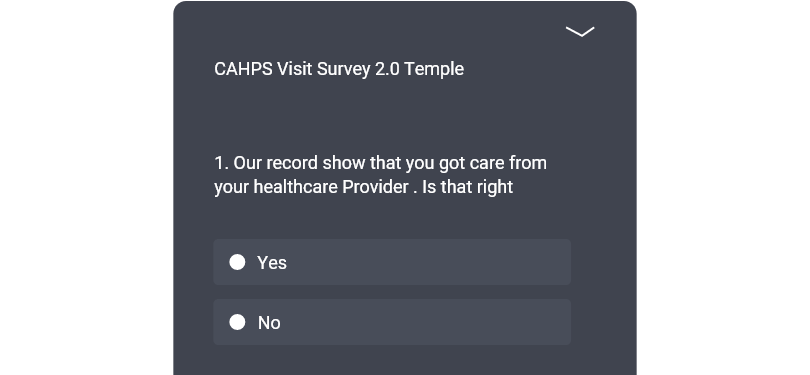
As you can see, it actively seeks feedback about their journey from start to finish and also evaluates the possibility of the patient recommending the healthcare provider to their family and friends.
Why Are Patient Surveys Important?
Let’s dive into why they hold such importance in the healthcare industry:
Insight into Patient Needs
Patient surveys give you a direct line to your patients’ thoughts and feelings. You get to see your healthcare services through their eyes, allowing you to identify areas of improvement and address unmet needs.
By actively listening to your patients, you can tailor your services to meet their expectations better. This personalization leads to improved patient experiences, fostering trust and loyalty.
Quality Assessment & Compliance
Patient surveys offer an invaluable opportunity to assess your quality of care. It helps you meet regulatory compliance requirements and maintain high standards in healthcare delivery.
Understanding your patients’ preferences and pain points allows you to create patient-centered strategies that resonate with your audience.
Staff Performance Evaluation
Not only do these surveys evaluate your services, but they also shed light on the performance of your healthcare staff. This feedback can be instrumental in identifying training needs and enhancing staff satisfaction.
Benchmarking & Comparison
With patient surveys, you can benchmark your performance against industry standards or even against your competitors. It’s like a report card that tells you how you fare in the healthcare arena.
7 Types of Patient Surveys in Healthcare
Let’s take a casual yet informative look at some common types of patient surveys:
| Type of Patient Survey | Definition | Data Collected |
| Overall Satisfaction Surveys | Comprehensive assessments of patients’ overall experiences with your healthcare organization. | Patients’ overall satisfaction with the care received and feedback on various aspects of their healthcare journey. |
| Experience Surveys for Specific Departments | Targeted feedback for specific departments like the emergency room, outpatient clinics, or inpatient wards. | Department-specific experiences, patients’ opinions on service quality, and improvement suggestions. |
| Provider Performance Surveys | Focus on patients’ interactions with individual healthcare providers, identifying areas of improvement and excellence. | Patients’ feedback on healthcare professionals’ communication, bedside manner, and overall quality of service. |
| Post-Discharge Surveys | Assess how patients are managing their recovery at home and identify any lingering concerns. | Patients’ post-discharge experiences, follow-up care effectiveness, and potential complications or issues. |
| Appointment and Scheduling Surveys | Gather feedback on appointment booking and scheduling processes, including wait times and convenience. | Patients’ opinions on the ease of scheduling, appointment punctuality, and overall appointment experience. |
| Health Outcomes Surveys | Evaluate the impact of treatments on patients’ health and well-being, identifying areas for improvement. | Data on patients’ health improvements, treatment efficacy, and potential side effects or complications. |
| Patient Demographics Surveys | Collect essential demographic information to tailor services to specific patient needs. | Patient demographic data such as age, gender, ethnicity, medical history, and specific health conditions. |
How to Create Effective Patient Surveys: 6 Key Tips
Let’s dive into some essential tips to help you design patient surveys that resonate with your patients and deliver meaningful data.
Define Clear Objectives
Before crafting your patient survey, clearly outline what you want to achieve. Are you seeking feedback on specific services, patient experiences, or overall satisfaction?
Having well-defined objectives will guide the survey design process and ensure you collect relevant data. Remember to include the keywords “patient surveys in healthcare” in your survey introduction, emphasizing its importance in enhancing patient care.
Keep it Concise & Relevant
Respect your patients’ time by keeping the survey concise and focused. Avoid overwhelming them with too many questions. Stick to topics that directly impact patient experiences and the services you provide. Relevant surveys are more likely to receive higher response rates and provide actionable insights.
For example, Qualaroo’s in-context surveys achieve higher rates (10-30%) due to their immediate placement within the user experience.
Use Simple & Understandable Language
Communicate clearly with your patients. Use language that is easy to understand, avoiding medical jargon or technical terms. The keywords “patient surveys” should naturally fit into the questions and instructions, making the survey accessible and user-friendly.
Ask Specific & Actionable Questions
Craft questions that are specific and allow for actionable responses. Open-ended questions can provide valuable qualitative data, while closed-ended questions with rating scales help qualify patient satisfaction.
The data collected through “patient surveys in healthcare” can pinpoint areas for improvement and guide your decision-making process.
Consider Timing & Methodology
Timing is crucial when conducting patient surveys. Sending surveys shortly after patient interactions ensures responses are fresh and accurate.
You can choose the appropriate survey methodology (online, phone, or paper-based) depending on your patient population and resources.
Ensure Anonymity
Reassure patients about the confidentiality of their responses. Anonymity encourages honest feedback, which is vital for authentic insights. Mention the privacy measures in your survey introduction to reinforce your commitment to respecting patients’ privacy in the surveys.
For more tips, you can check out our article on types of survey errors you should avoid to create effective surveys.
6 Effective Distribution Methods for Patient Surveys
Though HCAHPS has published rules and guidelines on how healthcare providers can collect patient feedback, you can target interactions across multiple platforms to gather insights about patients’ overall experience and outcomes at these points.
Email Surveys
Utilizing emails to distribute patient surveys offers a convenient and cost-effective approach. After patient interactions, such as appointments or procedures, healthcare providers can promptly send personalized survey links to patients’ email addresses.
Now, the challenge is how to encourage patients to respond? For this, you can craft engaging subject lines and clear instructions to motivate patients to participate and share their experiences.
You can easily design email surveys with tools like ProProfs Survey Maker and send them to the patient for quick feedback.
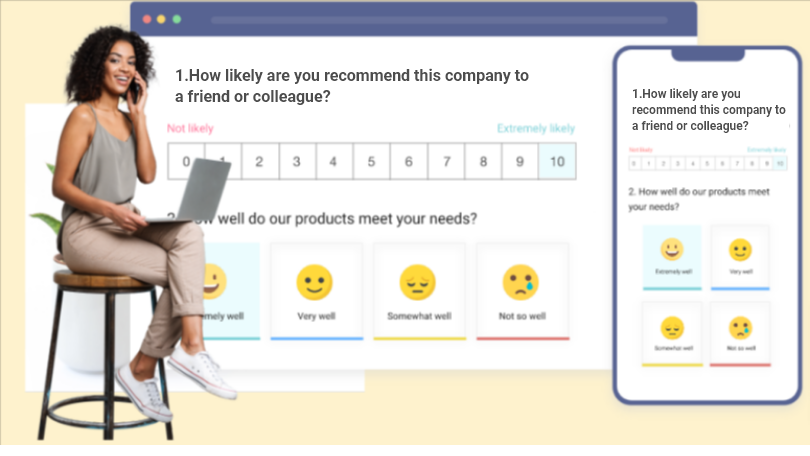
In-Person Surveys
In specific healthcare settings, such as hospitals, clinics, and medical offices, in-person surveys can be highly effective.
After completing appointments or medical procedures, healthcare personnel can hand out printed survey forms or provide QR codes that lead to online surveys. This personal touch enhances patient engagement and may lead to a higher response rate. Additionally, integrating survey functionalities into a hospital mobile app can further streamline the process, allowing patients to easily provide feedback through their smartphones at their convenience.
In-App Surveys
If you host an app, you can use a robust in-app feedback tool like Qualaroo to engage with the patients and collect feedback.
Just incorporate the patient survey into the applications and use the targeting options to trigger it when the patient accesses their report or a specific app page in their account.
This way, patients can conveniently access the surveys through the app after their appointments, ensuring a seamless experience and encouraging active participation.
Read More: In-app Survey Guide – Design, Best Practices & Examples
Interactive Voice Response (IVR) Surveys
IVR surveys are an automated telephone-based method of gathering patient feedback. Patients are prompted to respond to survey questions using their keypads through a pre-recorded phone call.
This approach is suitable for patients who prefer traditional communication methods and institutions that want to reach a large number of patients in a short period.
Telephone Surveys
Although similar to IVR surveys, conducting live telephone surveys involves personnel directly interacting with patients.
Trained surveyors can collect detailed feedback, address patient concerns, and establish a personal connection that enhances response rates. Telephone surveys are particularly useful for gathering comprehensive feedback from specific patient populations.
SMS (Text) Surveys
You can also use SMS to send the surveys to the patients. Tools like Qualaroo let you generate shareable links to include in the SMS. Patients can open the link and share their experience and feedback.
These concise surveys are ideal for capturing real-time experiences and opinions. Patients can respond quickly through text messages, making it an efficient method for busy healthcare consumers.
How to Analyze Patient Surveys for Actionable Insights
Gathering survey responses is only the first step; the true value lies in effectively analyzing the data to extract actionable insights. Let’s explore the essential steps for analyzing patient survey results for a comprehensive understanding of performance issues:
Step 1: Prepare and format the Data
Before diving into the analysis, it is crucial to prepare the survey data properly. It involves organizing and cleaning the data to ensure its accuracy and consistency.
Merge and standardize duplicate or inconsistent responses, and validate the data to identify and rectify missing or erroneous entries. A well-organized dataset will pave the way for more meaningful and accurate insights.
Step 2: Categorize the Feedback
Categorizing the survey responses is essential for a structured analysis. Identify key themes and topics that emerge from the feedback.
Common categories may include communication, wait time, staff behavior, facility cleanliness, and overall satisfaction. This step helps understand the most critical aspects of the patient experience.
You can also implement AI-based data analysis techniques like sentiment analysis and the word cloud generator to minimize the manual process. Today, many survey tools provide built-in AI tools that automatically categorize the data.
For example, the AI sentiment analysis engine of Qualaroo automatically identifies the key themes in the feedback data and categorizes them based on user emotions.
Likewise, the word cloud generator highlights the critical phrases in the data to help you recognize the consensus of the respondents.
Step 3: Run Quantitative & Qualitative Analysis
Quantitative analysis involves interpreting numerical data from survey responses. Calculate each category’s average scores, response frequencies, and relevant statistical measures. Identifying patterns and trends in the data allows healthcare personnel and businesses to prioritize improvement areas based on the prevalence and impact of specific issues.
In the same way, run a qualitative analysis to delve deeper into the underlying reasons behind the numerical scores.
Patient comments and open-ended responses provide valuable insights into the patient experience, capturing nuances and specific details that quantitative data might miss. You can also categorize and analyze these qualitative responses to extract common themes and sentiments.
Step 4: Combine O-Data & X-Data
It is essential to integrate operational data (O-data) with experience data (X-data) to gain a comprehensive understanding of performance issues.
O-data includes objective operational metrics such as wait times, appointment scheduling efficiency, and clinical outcomes. X-data, on the other hand, represents subjective feedback from patients about their experiences.
By combining both types of data, healthcare organizations can identify correlations between patient experiences and operational processes, enabling them to address underlying issues systematically.
Step 5: Extract Actionable Insights for Continuous Improvement
Ultimately, analyzing patient surveys aims to generate actionable insights that drive meaningful change.
Develop a comprehensive improvement strategy based on the analysis results. Set measurable goals, assign responsibilities, and establish timelines for implementing changes. Regularly track progress and reassess patient survey data to ensure continuous improvement.
Importance of Using Survey Software for Patient Surveys
Patient feedback is a valuable asset for healthcare professionals seeking to improve patient experiences and quality of care. That’s why leveraging professional survey software becomes essential to obtain a holistic view of the patient journey and unlock actionable insights,
For example, Qualaroo, a leading survey platform, offers healthcare professionals a powerful tool to efficiently administer and analyze patient surveys.
Here’s how Qualaroo can assist healthcare professionals in designing effective patient survey campaigns:
Flexible Survey Creation
Qualaroo offers a robust survey creation platform, allowing healthcare professionals to build customized patient surveys to suit their specific requirements.
With a wide range of question types, survey logic, and skip logic features, professionals can craft surveys that provide a comprehensive understanding of the patient journey.
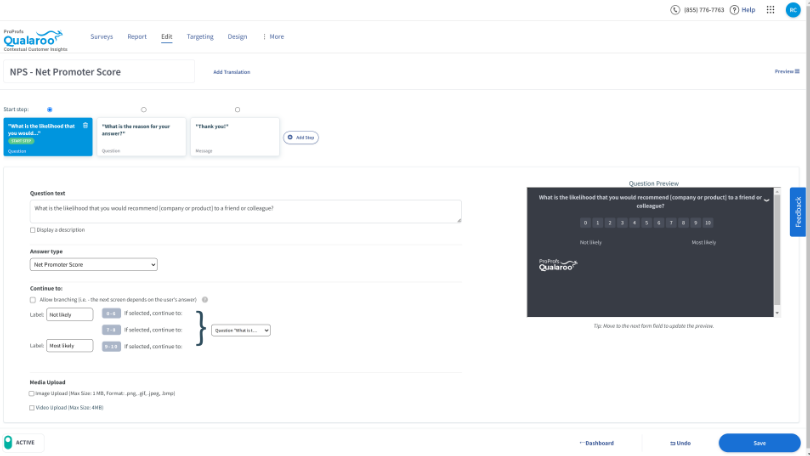
Read More: Skip Logic Survey – A Complete Guide on How to Design Branching Surveys
Targeted Survey Deployment
Qualaroo’s advanced targeting options enable healthcare professionals to deliver surveys to specific patient segments based on demographics, behaviors, or past interactions. The targeted approach ensures that the right patients receive the most relevant surveys.
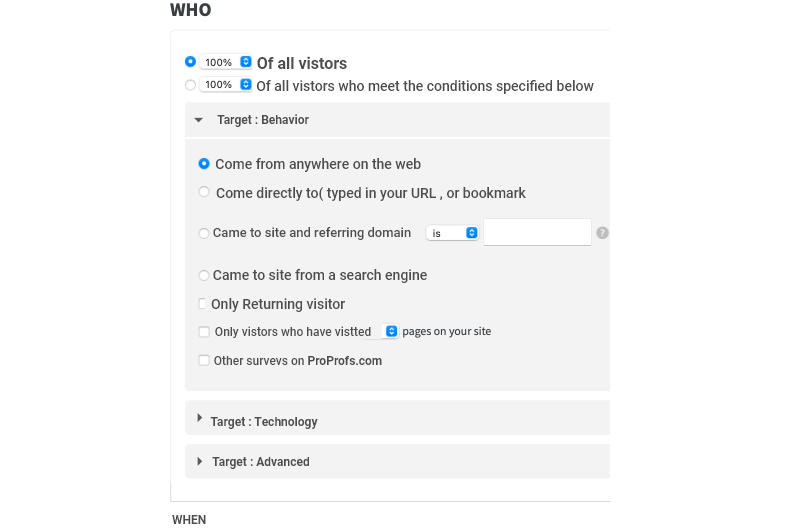
Real-time Insights
With Qualaroo’s real-time reporting, healthcare professionals gain immediate access to survey results as they arrive. It facilitates quick identification of emerging trends and pressing issues, enabling timely interventions and improvements.
AI-based analysis Tools
Qualaroo’s text analysis capabilities empower healthcare professionals to analyze open-ended responses efficiently.
As we mentioned above, the sentiment analysis and word cloud features help gauge patient emotions, sentiment, and overall satisfaction level, adding depth to the survey analysis.
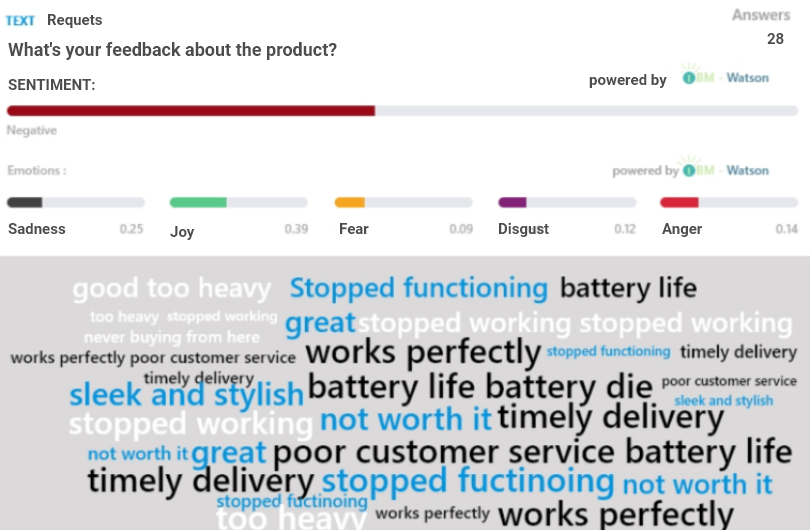
Embrace Patient Surveys for Thriving Healthcare Success
Patient surveys in healthcare are a transformative tool, holding the key to success for both healthcare professionals and businesses. By listening to patient feedback, providers can fine-tune their services, nurture patient loyalty, and pave the way for continuous improvement.
Embracing the insights gained from these surveys empowers us to create a healthcare landscape that thrives on empathy, compassion, and patient-centric care.
So, let patient surveys be the compass guiding us toward an extraordinary future of triumph and prosperity in the dynamic world of healthcare.
FREE. All Features. FOREVER!
Try our Forever FREE account with all premium features!

